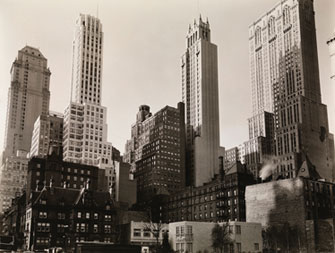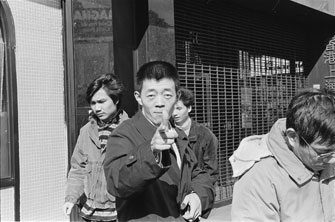Two Views of
New York City

”Park Avenue and 39th Street, New York, October 8, 1936.” © Berenice Abbott/Commerce Graphics Ltd, Inc.
Of the two new main exhibitions at Paris’s Jeu de Paume photography museum, “Interlacing,” the one focusing on contemporary artist Ai Weiwei (b. 1957), currently in the news because of his conflicts with and recent imprisonment by the Chinese government, overshadows the show of the work of Berenice Abbott (1898-1991), not just because the former is in the limelight, but also because of the comparative freshness and spontaneity of his work.
The Abbott show starts with a nice series of portraits of literary and artistic celebrities in Paris in the 1920s, many of the same ones who were later photographed by Gisèle Freund, including James Joyce and Jean Cocteau. One lovely image shows Cocteau’s delicate, feminine hands, and another, of Solita Solano, depicts the writer in a dramatically slumped position.
Next come Abbott’s portraits of New York City and America. A champion of the great French photographer Eugène Atget, Abbott helped bring his work – done on commission to document the streets of Old Paris before they were destroyed by Baron Haussmann – to the attention of the public, and even owned part of his archive. In most of the photos shown here, she was working in the same documentary spirit as Atget – recording life in the streets of New York and as seen from the road all over America à la Walker Evans – but her photos lack the somber beauty of those of Atget and Walker. With several notable exceptions (some of her views of New York City architecture, for example, and one of the elevated subway taken in 1936), many of them seem banal today – been there, seen that done better.
The best images in the show are those she did to help popularize science. Working for the magazine Science Illustrated, she created beautiful abstract images to illustrate such processes as the transformation of energy and the movement of a bouncing ball.
Part of the Jeu de Paume’s laudable series of exhibitions featuring the work of 20th-century women photographers, this retrospective seems fragmented and rather dull.
In comparison, Ai Weiwei’s black-and-white photos of himself, his friends and events in New York City in the 1980s really bring the

”Gu Changwei,Chinese New Year on Mott Street” (1989). © Ai Weiweicity to life, perhaps because a real personality and a strong (anti-establishment) point of view come through in a way they don’t in Abbott’s views of the city.
While a lot of Ai’s photos show more concern for content than technique, with images of such everyday scenes as his friends watching TV, drinking beer or playing pool in a bar, washing clothes in the Laundromat, etc., they form a livelier, more compelling portrait of the city. These intimate scenes (some featuring Ai’s friend, the poet Allen Ginsburg) contrast with images of public happenings in the streets – bloodied demonstrators being dragged away by cops, people playing in a fountain, etc. – that are like quirky news photos.
The later photo series in the show, taken in China and in color, are less convincing. The one in which we see a hand giving the finger to various monuments – the White House, the Eiffel Tower, etc. – seems rather juvenile.
Ai is to be admired not only for his varied talents – in addition to photography, he does sculpture, architecture (he collaborated with Herzog & de Meuron on the Bird’s Nest Beijing National Stadium built for the 2008 Olympics), installations and films – but also for his courage in standing up to the Chinese government in spite of real threats to his livelihood and freedom.
Galerie nationale du Jeu de de Paume: 1, place de la Concorde, 75008 Paris. Métro: Concorde. Tel.: 01 47 03 12 50. Open Tuesday, 11am-9pm; Wednesday-Sunday, 11am-7pm. Admission €8.50. Through April 29. www.jeudepaume.org
Please support Paris Update by ordering books from Paris Update’s Amazon store at no extra cost. Click on your preferred Amazon location: U.K., France, U.S.
Reader Reaction: Click here to respond to this article (your response may be published on this page and is subject to editing).
More reviews of Paris art shows.
© 2012 Paris Update
Favorite